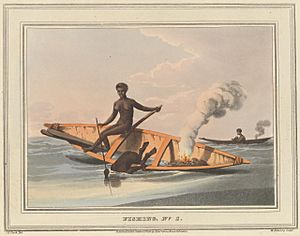John Heaviside Clark facts for kids

John Heaviside Clark (born around 1771, died in 1863) was a talented Scottish artist. He was known for making beautiful pictures of the sea and landscapes, which are scenes of nature. He also created art using a special printing method called aquatint. People sometimes called him Waterloo Clark because he drew sketches right on the battlefield after the famous Battle of Waterloo.
Contents
An Artist of Many Talents
John Heaviside Clark was a very active artist. He often showed his paintings at the Royal Academy, a famous art institution in London. He exhibited his work there regularly between 1801 and 1832. This means his art was seen by many people for over 30 years!
Clark was skilled at painting different types of scenes. He loved to paint seascapes, which are pictures of the ocean, ships, and coastal areas. He also painted landscapes, showing beautiful natural views like mountains, forests, and rivers.
What is Aquatint?
Besides painting, John Heaviside Clark was also an expert in aquatint. This is a special way of making prints that looks a lot like watercolor paintings. It uses acid to create different shades and tones, making the pictures look very detailed and artistic.
The "Waterloo Clark" Nickname
One of John Heaviside Clark's most interesting nicknames was Waterloo Clark. He earned this name because of something very unique he did. Right after the famous Battle of Waterloo in 1815, he went to the battlefield. There, he made quick sketches of what he saw. These drawings captured the scene directly after one of history's most important battles.
Sharing His Art Knowledge
John Heaviside Clark wasn't just an artist; he also shared his knowledge with others. He wrote books to teach people about art. In 1807, he published a book called A practical essay on the art of Colouring and Painting Landscapes. This book included illustrations to help people learn how to color and paint landscapes.
Later, in 1824, he released another book titled A practical Illustration of Gilpin's Day. This book had thirty colorful pictures. These pictures were based on simpler, single-color studies by another artist named William Gilpin. Clark's book showed how different times of day could be represented in art.
His Life's End
John Heaviside Clark lived a long life dedicated to art. He passed away in Edinburgh, Scotland, in 1863. His work as a painter and engraver, and his efforts to teach others about art, left an important mark on the art world of his time.
Sources
 This article incorporates text from a publication now in the public domain: Bryan, Michael (1886). "Clark, John Heaviside". Bryan's Dictionary of Painters and Engravers (A–K) (3rd) I. London: George Bell & Sons.
This article incorporates text from a publication now in the public domain: Bryan, Michael (1886). "Clark, John Heaviside". Bryan's Dictionary of Painters and Engravers (A–K) (3rd) I. London: George Bell & Sons.


